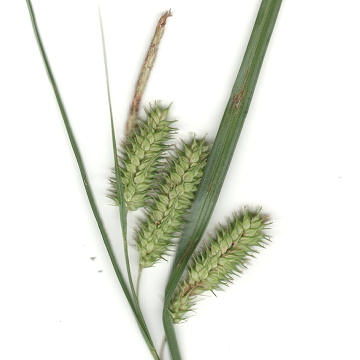

Carex hystericina - (image 1 of 5)
Taxonomy
Family: Cyperaceae
Section Vesicariae
Habitat
Swamps, wet meadows, shores, calcareous fens.
Associates
Distribution
New Brunswick and Quebec west to WA, south to VA, KY, TX, and CA.
Morphology
Perennial from a short, stout rhizome to 1 m; stems slender; lowest bract somewhat surpassing the inflorescence, without a sheath or with only a short sheath; other bracts reduced or lacking; leaves often septate-nodulose, especially the sheaths, the blade long and flat, to 9 mm wide; pistillate spikelets cylindric, to 4 cm long and 1.5 cm wide, the lowest pedunculate, the upper often subsessile; mature perigynia numerous, crowded, spreading or ascending (not reflexed), prominently 15-20-nerved, thin-textured, nearly round in cross-section, abruptly narrowed to the beak, scarcely stipitate; pistillate scale with a short, hyaline body and prominent rough awn 2-6 mm long; stigmas 3; achenes trigonous; style persistent.
Notes
Fruiting May to July.
Wetland indicator: OBL
The specific epithet is sometimes spelled hystricina, and although this is incorrect it makes more sense given that Hystrix is Latin for porcupine. This species is similar to C. lurida (Sallow Sedge) and C. comosa (Bristly Sedge), the former having more upright and sessile spikes and the latter with more numerous perigynia with longer perigynia teeth.
References
Gleason, Henry A. and A. Cronquist. 1991. Manual of Vascular Plants of
Northeastern United States and Adjacent Canada. Second Ed.
The New York Botanical Garden. Bronx, NY
Swink, F. and G. Wilhelm. 1994. Plants of the Chicago Region.
Indiana Academy of Science. The Morton Arboretum. Lisle, Illinois.
|
© Michael Hough 2010 |